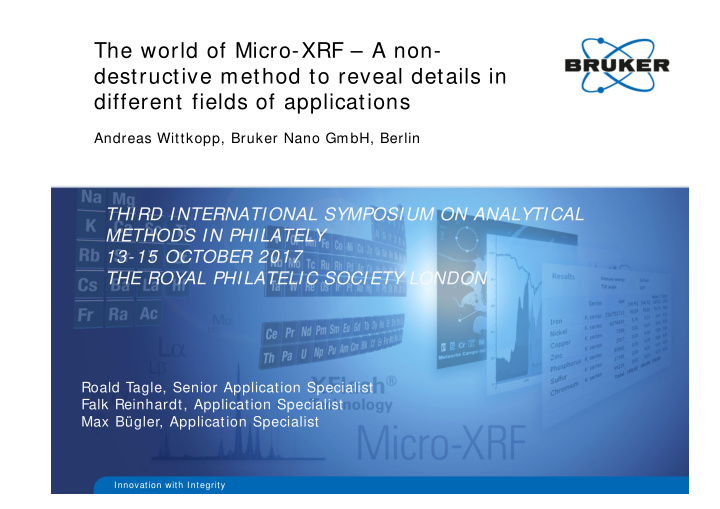



The world of Micro-XRF – A non- destructive method to reveal details in different fields of applications Andreas Wittkopp, Bruker Nano GmbH, Berlin THIRD INTERNATIONAL SYMPOSIUM ON ANALYTICAL METHODS IN PHILATELY 13-15 OCTOBER 2017 THE ROYAL PHILATELIC SOCIETY LONDON Roald Tagle, Senior Application Specialist Falk Reinhardt, Application Specialist Max Bügler, Application Specialist Innovation with Integrity
Introduction to Micro-XRF 2
Introduction to Micro-XRF Basic layout • Excitation of an atom by high energetic radiation • Generation of a vacancy • Fill up this vacancy by outer electrons • Em ission of a characteristic X-ray photon • Fluorescence yield depends on atom ic num ber (low for low atom ic num ber and vice versa) 3
Comparison of NZ45 and NZ23, 1.5mm Collimator
Introduction to Micro-XRF Benefit of capillary optics Comparison of collimator and focusing device Æ Source Optic Captured Trans- Brilliance Input angle mission / norm / mm / sr / % for area 7 • 10 -5 Colli 1 100 1 6 • 10 -5 » 85 » 10 Monocap 0.3 2 • 10 -3 » 10 » 5000 Polycap 3 Sample 5 15.10.17 5
Resolution 20 µ m Resolution 1mm Resolution 1cm 15.10.17
Introduction to Micro-XRF Detectable elements in vacuum and air Not available Not possible Only in vacuum (with M4) In air 15.10.17 7
Instrument design Instrument versions M1 ORA M1 Mistral Small unit in particular for Larger unit for different applications jewelry analysis also coating analysis, RoHs 8 15.10.17 Bruker Confidential
Instrument design M4 Tornado Unique features • Large, vacuum tight sample chamber • Fast X-Y-Z-stage for distribution analysis “on the fly” • Two optical microscopes for sample view with different magnifications • Small spot size (< 20 µ m) and high excitation intensity due to capillary optics 9 15.10.17
Applications - Forensics Analysis of banknotes 15.10.17 10
Applications - Forensics Analysis of banknotes 15.10.17 11
Applications - Forensics Analysis of ink Collection of different types of paper and inks were scanned 15.10.17 12
Applications - Forensics Analysis of inks 15.10.17 13
Applications - Archeometry Analysis of historic documents 4 x 12 cm 2 , 300 x 800 Pixel, 100 ms/Pixel Fe Ca Pb K, Ca, Fe, Hg, Pb 15.10.17 14
Applications - Archeometry Analysis of documents - Fe-intensity as 3D profile Fe-intensity as 3D profile 15.10.17 15
Micro XRF - Other applications Reconstruction of faded photographs Photo: 7.5 cm x 7.5 cm Fade image, details are still recognizable … Reconstruction of the picture from the Ag- L intensity 50 µ m step size 25 µ m step size 260 pixel x 160 pixel 520 pixel x 320 pixel 10/ 15/ 17 16
Other applications Reconstruction of faded photographs Photo: 7.5 cm x 7.5 cm Scan-step size: 22 µ m 4 Scans with 1800 pixel x 1800 pixel 13 Mpixel image 15.10.17 17
Reveal of hidden details Rembrandt 190.5 x 280.5 cm This is Rembrandt’s first and only corporate group portrait. The Syndics stands out for its exceptionally large format and more than life-sized figures. All eyes of the sampling officials – who assessed the quality of dyed cloth – are turned to us and one figure even rises from his chair as if to acknowledge our presence. Because of the low Rembrandt and/or studio, The Syndics of the Amsterdam Drapers' vantage point, the table Guild, known as the ‘Sampling Officials’ , 1662, canvas, 190.5 x 280.5 seems to jut out of the cm, Rijksmuseum NL picture. 18
Reveal of hidden details Rembrandt 190.5 x 280.5 cm 19
Reveal of hidden details Rembrandt 190.5 x 280.5 cm 20
Reveal of hidden details Rembrandt 190.5 x 280.5 cm 21
Micro-XRF Conclusion • Non destructive method which requires minimal to no sample preparation • Optical microscope and XYZ stage allows precise navigation to area of interest • Fast mapping down to 1ms/ pixel and high spatial resolution of 5000x5000 pixel allows high resolution elemental mapping and line- scans • Allows distributional analysis (elements and phases) • Improve detection limits (10x or better) compared to SEM/ EDS • Greater penetration depth than SEM/ EDS • Vacuum or air analysis, allowing liquids to be analyzed 15.10.17 22
Recommend
More recommend